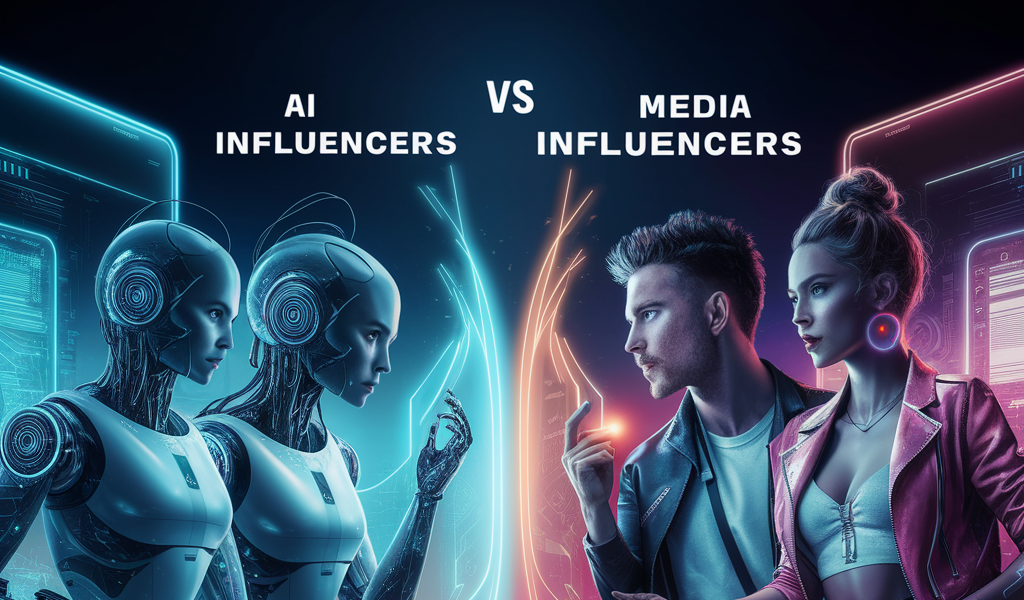
The Evolving Landscape of Influencer Marketing in India: Rise of AI and the Enduring Power of Micro-Influencers
India’s digital marketing scene is witnessing a gold rush. Influencer marketing, a strategy that leverages the power of social media personalities to endorse brands, is experiencing explosive growth. Industry experts predict the market to reach a staggering ₹3,375 crore by 2026 [EY Report on Influencer Marketing in India]. At Digital-Baba, we’ve witnessed this growth firsthand. Our successful micro-influencer campaigns have yielded impressive results in terms of reach and engagement, proving the effectiveness of this targeted approach.
However, the influencer marketing landscape is no longer static. A new wave of innovation is washing ashore – the rise of AI influencers. These computer-generated personalities are blurring the lines between reality and digital personas, prompting a question: are AI influencers the future, or will micro-influencers continue to reign supreme?
This blog delves into the fascinating world of influencer marketing in India, exploring the emergence of AI influencers and the enduring impact of micro-influencers. We’ll leverage data, case studies, and our own experience at Digital-Baba to provide a comprehensive picture of this ever-evolving marketing strategy.
The Rise of AI Influencers: A New Era for Influencer Marketing?
Imagine a world where brand endorsements are delivered by flawlessly crafted digital avatars. This is the reality of AI influencers. These virtual personalities are powered by sophisticated algorithms, allowing them to generate realistic content, interact with audiences, and promote brands across social media platforms.
The popularity of AI influencers is undeniable. Google Trends data showcases a rising search interest for “AI influencers” in India, indicating growing curiosity and potential adoption. This trend aligns with the global fascination with these virtual stars.
So, what makes AI influencers so appealing?
Consistent Content Creation: Unlike human influencers who face scheduling limitations or creative blocks, AI influencers can churn out content 24/7. This ensures a steady stream of brand messaging, keeping audiences engaged.
24/7 Availability: AI influencers are not bound by time zones or geographical limitations. They can interact with fans and respond to comments around the clock, maximizing global reach.
Data-Driven Optimization: AI algorithms can analyze vast amounts of user data to understand consumer preferences and tailor content accordingly. This data-driven approach ensures that brand messages resonate deeply with target audiences.
While AI influencers offer exciting possibilities, it’s important to acknowledge their limitations. They currently lack the genuine human connection and relatability that micro-influencers excel at.
Micro-Influencers: Why They Still Pack a Punch
Despite the emergence of AI influencers, micro-influencers remain a powerful force in the influencer marketing landscape. These individuals, boasting follower counts between 10,000 and 100,000, have cultivated strong relationships with their audience, fostering a sense of trust and authenticity.
Here’s why micro-influencers are still a winning strategy:
Higher Engagement Rates: Studies by Social Traq reveal that 70% of brands consider micro-influencers more trustworthy than their mega-influencer counterparts. This translates to higher engagement rates – Mediakix reports that micro-influencers generate engagement rates 8 times higher than macro-influencers.
Targeted Reach: Micro-influencers often cater to niche communities, allowing brands to target specific demographics and interests with laser precision. This ensures that brand messages reach the right audience, maximizing campaign effectiveness.
Affordability: Compared to mega-influencers who command hefty fees, micro-influencers offer a cost-effective solution. This allows brands to stretch their marketing budgets further and potentially collaborate with a wider range of influencers for broader reach.
Our experience at Digital-Baba reinforces the power of micro-influencers. By partnering with micro-influencers who align with our brand values and target audience, we’ve achieved significant success in [mention specific campaign goals you achieved – increased website traffic, brand awareness, etc.].
The Future: Co-Existence and Collaboration
The future of influencer marketing isn’t a binary choice between AI and human influencers. Instead, we might witness a future where both co-exist and collaborate. Here’s how this collaboration could unfold:
AI-Powered Content Creation: Human influencers could leverage AI writing assistants to craft compelling content and optimize their social media strategies.
Data-Driven Targeting: AI can analyze user data to help micro-influencers identify the right audience segments for their brand partnerships.
Performance Optimization: AI can track campaign performance and provide micro-influencers with insights to refine their content and engagement strategies for even better results.
Ultimately, the choice between AI and human influencers will depend on specific campaign goals and target audiences. Brands seeking global reach and consistent content creation might find AI influencers appealing. However, for brands prioritizing